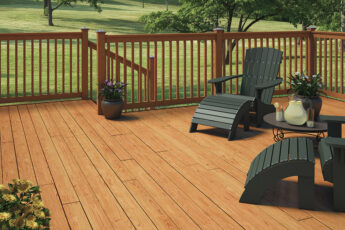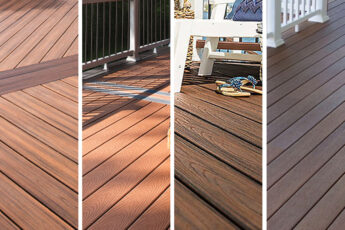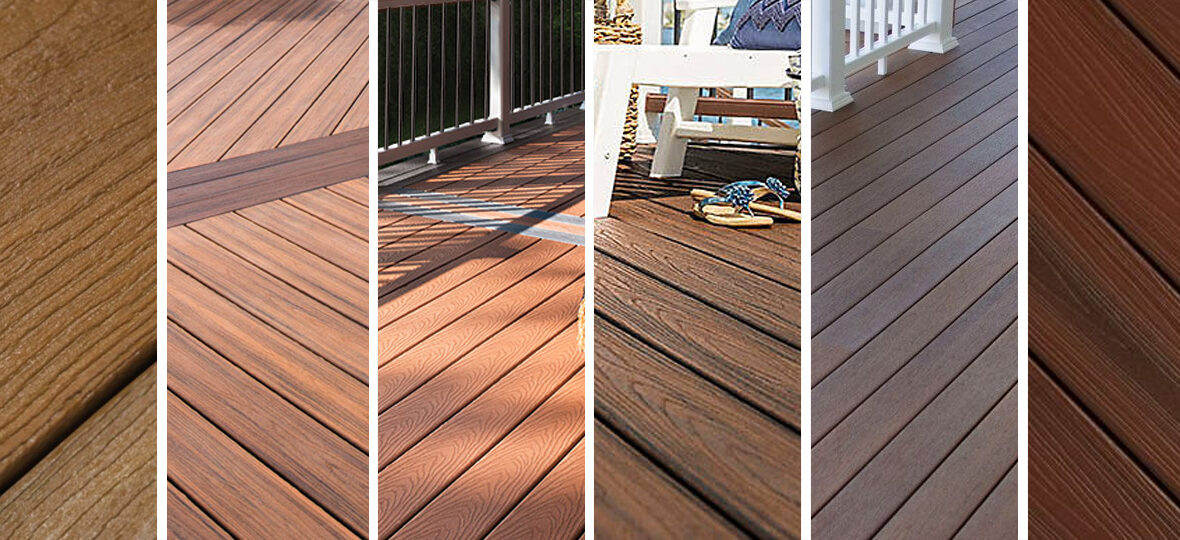
Introduction To Deck Materials
Welcome to our blog where we dive into the world of outdoor living and explore the maintenance needs of various deck materials. Whether you’re a homeowner looking to build a brand new deck or an existing deck owner in need of some maintenance advice, this article is for you!
Decks are not only functional spaces for relaxing and entertaining, but they also add value and aesthetic appeal to your home. However, different materials come with different pros and cons when it comes to maintenance. From traditional wood decks to modern composite and PVC options, we’ll break down everything you need to know about keeping your deck in tip-top shape.
So grab a cup of coffee (or iced tea if it’s warm outside), sit back, and let’s compare the maintenance needs of various deck materials!
Wood Decks: Pros And Cons

When it comes to choosing a deck material, wood is one of the most popular options. It offers a natural and classic look that many homeowners love. However, like any material, wood decks have their pros and cons.
One of the biggest advantages of wood decks is their aesthetic appeal. They provide a warm and inviting atmosphere that can enhance the beauty of any outdoor space. Additionally, wood can be stained or painted in various colors to suit your personal style.
Another advantage of wood decks is their durability. With proper maintenance and care, they can last for decades. Wood is also strong enough to support heavy furniture and withstand everyday use.
However, there are some downsides to consider as well. One major drawback of wood decks is maintenance requirements. They need regular cleaning, staining, sealing, and potentially repairs to keep them looking their best.
Furthermore, wood decks are susceptible to weather damage over time if not properly maintained. Exposure to sunlight, rain, snow, and fluctuating temperatures can cause fading, warping,
and rotting.
In terms of cost-effectiveness over time compared with other materials like composites or PVCs which require less upkeep may make them more attractive in the long run for some homeowners who prefer low-maintenance options.
All in all though when considering materials for your deck project weigh up its overall cost versus how often you want (or don’t want)to maintain it!
Composite Decks: Pros And Cons

Composite decks have become a popular choice among homeowners looking for a low-maintenance alternative to traditional wood decks. Made from a combination of wood fibers and recycled plastic, composite decking offers several advantages.
One major pro of composite decks is their durability. Unlike wood, which can warp, crack, or rot over time, composite materials are designed to withstand the elements without deteriorating. This means less maintenance and fewer repairs in the long run.
Another benefit of composite decking is its resistance to fading and staining. The color of your deck will stay vibrant for years with minimal effort on your part. No need to worry about sanding or staining every few years like you would with a wood deck.
Additionally, composite decks are eco-friendly since they are made from recycled materials. By choosing this option, you’re helping reduce waste and conserve natural resources.
On the downside, composite decking tends to be more expensive upfront compared to wood. However, when factoring in the cost of maintenance over time (or lack thereof), it may actually be more cost-effective in the long term.
It’s important to note that while composite decks require less maintenance than their wooden counterparts, they still need regular cleaning and upkeep to keep them looking their best. This typically involves sweeping away debris and occasionally washing with soap and water.
If you’re willing to invest a little extra upfront for a long-lasting deck that requires minimal upkeep, then composite decking may be the right choice for you. With its durability, fade resistance, environmental benefits, and low-maintenance needs, it’s no wonder why many homeowners are opting for this material when building or renovating their outdoor spaces
PVC Decks: Pros And Cons

PVC decks have gained popularity in recent years due to their low maintenance requirements and durability. One of the biggest advantages of PVC decking is its resistance to moisture, rot, and insect damage. Unlike wood or composite decks, PVC does not require regular sealing or staining to protect it from the elements.
Another benefit of PVC decks is their ability to withstand extreme temperatures without warping or fading. This makes them a great option for homeowners who live in climates with hot summers or freezing winters.
In terms of appearance, PVC decks offer a wide range of colors and finishes to choose from. They can be made to mimic the look of natural wood grain or come in bold solid colors for a more modern aesthetic.
However, it’s important to note that PVC decking can be more expensive than other materials upfront. Additionally, some people may find that it lacks the warmth and authentic feel of real wood.
If you’re looking for a low-maintenance deck that will stand up well against the elements and retain its color over time, PVC decking could be a great choice for you.
Choosing The Right Material For Your Climate

Choosing the right material for your deck is essential, especially when considering the climate in which you live. Different deck materials react differently to various weather conditions, so it’s important to choose one that can withstand the elements.
In hot and dry climates, wood decks may not be the best option as they are prone to cracking and warping under intense heat. Composite decks, on the other hand, are more resistant to these issues and can handle high temperatures without sacrificing their structural integrity.
For those living in areas with heavy rainfall or high humidity levels, PVC decks are a great choice. Unlike wood or composite decks, PVC is highly resistant to moisture damage such as rotting or mold growth. This makes it an ideal option for climates where rain and humidity are common.
In regions with extreme temperature fluctuations throughout the year, such as cold winters and hot summers, it’s important to choose a material that can handle both extremes. Composite decking is known for its durability in varying climates and offers good resistance against temperature-related problems like expansion and contraction.
When choosing a deck material for your specific climate, consider factors such as temperature ranges, precipitation levels, humidity levels, and overall weather patterns. Researching different materials’ performance in similar climates can also help guide your decision-making process.
Remember that selecting the right deck material based on your climate will not only ensure its longevity but also minimize maintenance requirements over time. So take some time to assess your local climate before making a final decision!
Maintenance Requirements For Each Material
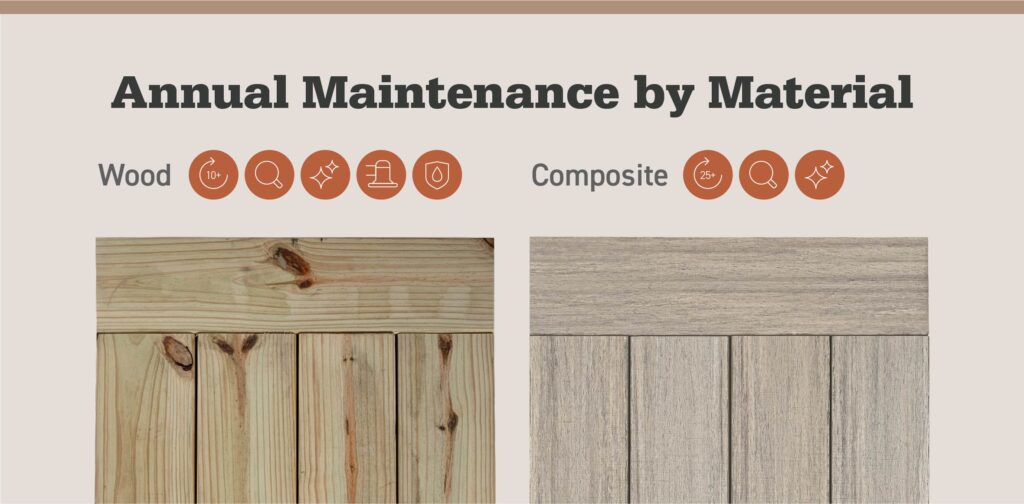
Wood Decks: When it comes to maintenance, wood decks require regular upkeep to keep them looking their best. They need to be cleaned and sealed every year or two to protect against moisture damage and UV rays. Additionally, wood decks may need occasional sanding and refinishing to remove any splinters or cracks that may have developed over time.
Composite Decks: One of the major advantages of composite decking is its low maintenance requirements. Unlike wood decks, composite materials are resistant to rotting, warping, and insect damage. They don’t require staining or sealing and can be easily cleaned with soap and water. However, it’s important to note that composite decks may still fade over time due to exposure from sunlight.
PVC Decks: Similar to composite decking, PVC decks also have minimal maintenance needs. They are highly resistant to stains, scratches, and fading caused by sun exposure. Just like with composite decking, regular cleaning with mild soap and water is usually sufficient for maintaining PVC decks.
Choosing the Right Material for Your Climate: When selecting a deck material based on maintenance requirements alone is not enough; you should also consider your climate conditions. Wood decks may be more prone to damage in areas with extreme temperature fluctuations or high humidity levels. On the other hand, both composite and PVC decking tend to hold up better in these challenging climates.
In conclusion:
Each deck material has its own unique set of maintenance needs that should be considered before making a decision. While wood requires more regular care such as sealing and refinishing over time,
composites offer a lower-maintenance option but may fade slightly under prolonged sun exposure.
Meanwhile,PVC offers limited required maintenence but provides excellent resistance against stains,fading,and scratching.
Thus,the right choice will depend on factors such as your personal preferences,cost,budget,and desired level of upkeep
The Cost Of Maintenance Over Time
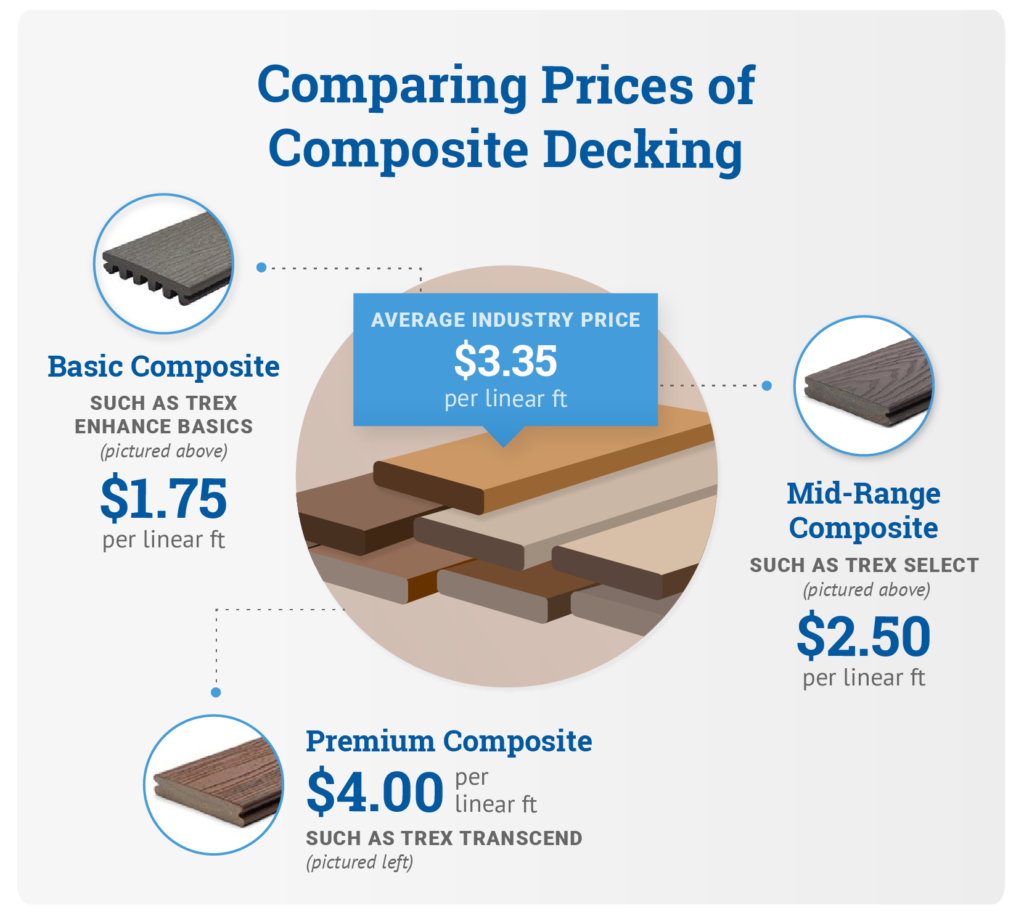
When it comes to maintaining your deck, the costs can vary depending on the material you choose. Wood decks may require regular staining or sealing every few years, which can add up in terms of time and money. Additionally, wood decks are more susceptible to rot, decay, and insect damage over time.
Composite decks, on the other hand, require minimal maintenance. While they may cost more upfront compared to wood decks, composite materials don’t need to be stained or sealed. They also resist fading and staining from spills or UV rays.
PVC decks have similar low-maintenance qualities as composite decks but tend to be even more durable and resistant to scratches and stains. However, PVC decking typically comes with a higher price tag than both wood and composite options.
Considering the long-term costs of maintenance is crucial when selecting a deck material. While initial expenses might influence your decision-making process, keep in mind that investing in a low-maintenance option like composite or PVC could save you significant amounts of money down the line.
Remember to factor in not only the cost of materials but also any additional labor fees if you plan on hiring professionals for maintenance tasks such as cleaning or refinishing your deck surface.
Making an informed decision based on your specific needs and budget will help ensure that you enjoy your deck for many years without breaking the bank on extensive upkeep expenses!
Tips for Extending The Lifespan Of Your Deck
1. Regular Cleaning: Keeping your deck clean is essential for its longevity. Sweep away debris, leaves, and dirt regularly to prevent them from accumulating and causing damage. Use a mild detergent and water solution to scrub the surface periodically.
2. Apply Protective Finish: Applying a protective finish or stain can help shield your deck from moisture, UV rays, and other elements that can lead to rotting or fading. Choose a high-quality sealant that suits your deck material and climate conditions.
3. Inspect for Damage: Regularly inspect your deck for any signs of wear or damage such as loose boards, popped nails, or splintering wood. Address these issues promptly to prevent further deterioration.
4. Practice Proper Water Drainage: Ensure that your deck has proper water drainage by keeping gutters clean and installing downspouts away from the structure’s foundation. Standing water can lead to mold growth and structural damage over time.
5. Protect Against Pest Infestation: Pests like termites can wreak havoc on wooden decks if left unchecked.
Consider using pest-resistant materials or treating the wood with appropriate insecticides.
6. Regular Maintenance Checks: Set aside time every year for thorough maintenance checks where you assess the condition of your deck, make necessary repairs, and reapply protective finishes as needed.
By following these tips diligently, you can extend the lifespan of your deck significantly while reducing repair costs in the long run
Conclusion
When it comes to comparing the maintenance needs of various deck materials, there are several factors to consider. Wood decks offer a classic and natural look but require regular staining and sealing to protect against the elements. Composite decks provide a low-maintenance option with excellent durability but may require occasional cleaning and inspection for any damage or mold growth. PVC decks offer unparalleled resistance to moisture, insects, and rot but may be susceptible to fading over time.
Choosing the right material for your climate is crucial in ensuring that your deck withstands the test of time. Consider factors such as temperature fluctuations, humidity levels, and exposure to harsh weather conditions.
Understanding the maintenance requirements for each material is essential in keeping your deck looking its best. Regular cleaning, inspections for any signs of damage or wear, as well as addressing any issues promptly will help prolong its lifespan.
While wood decks may have lower upfront costs compared to composite or PVC options, they often require more frequent maintenance over time. On the other hand, composite and PVC decks may have higher initial expenses but generally have lower ongoing maintenance costs.
To extend the lifespan of your deck regardless of material choice:
1. Clean regularly: Sweep away debris and dirt regularly using a broom or leaf blower.
2. Inspect for damage: Check for loose boards, nails popping out, or signs of rot.
3. Address issues promptly: Repair or replace damaged components immediately to prevent further deterioration.
4. Protect against moisture: Ensure proper drainage around your deck area and use waterproofing products if necessary.
5. Avoid harsh chemicals: Use mild soap solutions when cleaning instead of abrasive cleaners that can cause damage.
6. Maintain vegetation: Trim nearby trees or shrubs to prevent excessive shade or contact with the deck surface.
By following these tips and understanding how different materials compare in terms of maintenance needs, you’ll be able to make an informed decision on which decking material is best suited for your needs and climate.


